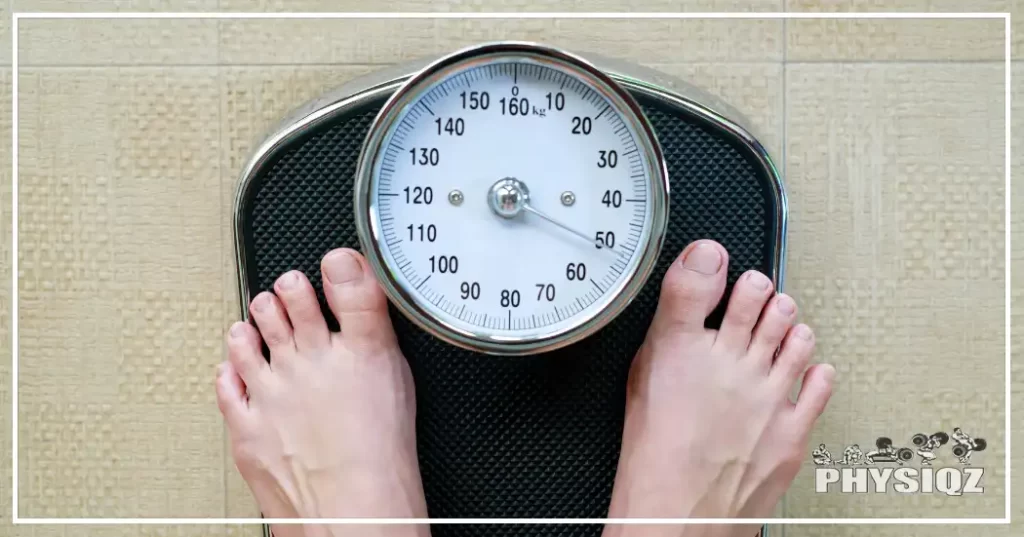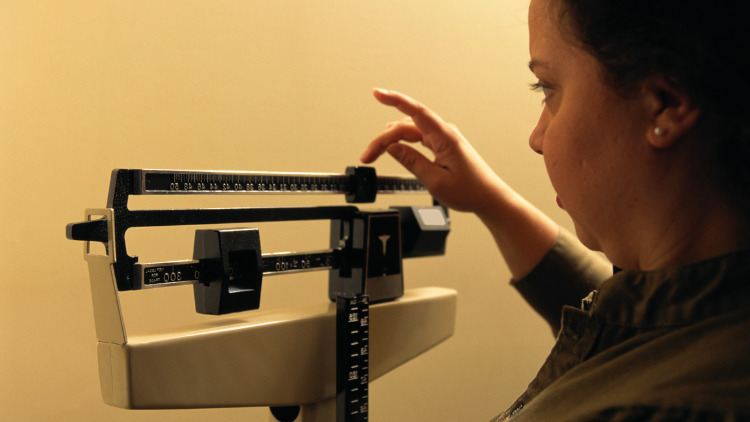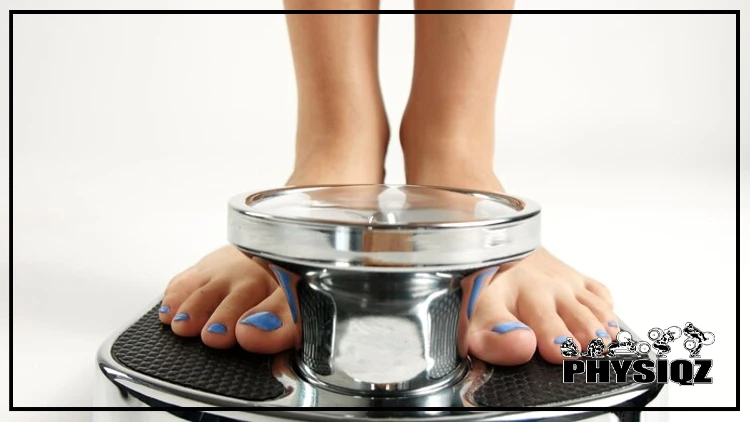
Focusing too much on the numbers on the scale can be tiring, yet understanding why the scale isn’t important might be crucial to overcoming the mental challenges of weight loss.1 And honestly, the reason it doesn’t matter is not what you think because the scale lies since it doesn’t take into consideration why your body weight fluctuates or weighing inaccuracies. Not to mention the emotional distress it may bring about even though weight loss can still be achieved without obsessing over the scale.
It is easy to become laser-focused on a number but there’s times when it truly should be disregarded so you can see progress despite what some pesky number says!
Why Doesn’t the Weight on the Scale Matter? What the Scale Doesn’t Tell You
While a scale was designed to measure weight, it is important to remember the many things that can affect the accuracy of its readings before letting it hinder or derail momentum. Scales display a weight that includes lean body mass and fat, but what it doesn’t account for is how much of that displayed weight is only temporary due to sodium intake, glycogen stores, hormones, and other added water weight as well mechanical issues and errors.
The Scale is Not Accurate – Inaccuracies of Body Weight Scales
Because body weight scales are a human invention and mass-produced, there is no circumstance that can allow for 100% reliable results throughout every environment. Outside factors that can influence scale discrepancies are:
- Calibration – Scales must be calibrated to ensure they are beginning with a reading of zero. Each scale is different and the amount of time needed between each calibration can vary.
- Surface – The type of surface that the scale is sitting on can play a role in whether a correct or consistent reading is given. Even if the scale is on a seemingly flat surface, a small incline or groove in the tile might make a difference.
- Debris Build–Up – If dirt or grime is caked on the outside or underneath the scale, it can affect the results of a weigh-in. Some common household examples are pet or human hair, hair products, dust, and cleaning product build-up.
- Power – If a digital scale is being used, battery life is fairly short and can affect readings when starting to run low.
- Damage – If the scale has begun to rust from being located in a steamy bathroom or has been dropped, there is a chance that, even if calibrated, weight readings could be off due to device deterioration.
Each of the factors mentioned might not lead to significant changes in weight readings, but even minor inaccuracies illustrate why relying on the scale is unimportant and can negatively impact dieters’ attitudes toward weighing themselves.

Source: rattanakun via Canva.com2
The Scale Can’t Tell the Difference Between Muscle Weight & Fat
A majority of those familiar with the exercise world has heard the phrase “muscle weighs more than fat”. While this is not technically true due to the fact that one pound of muscle is still equal to one pound of fat, what the saying is trying to convey is that muscle is more dense than fat.3
Ultimately, what this means is, that if a gym goer has consistently been working with a weight training routine, the muscle gained during these routines might occupy a smaller space in the body than the fat that was lost during that time frame.
For example, if 1 pound of muscle is gained in one month, but 1 pound of fat is also lost in that same month, the scale will show a 0 pound net loss. So it truly doesn’t matter what the scale reads because the body is reaping the benefits of the workouts through muscle gain and fat loss.
Sodium Effects the Weight on the Scale
While sodium is an important part of a healthy diet, the recommended daily value is between 1,500 and 2,300 milligrams per day. It might come as no surprise that after consuming a salty meal, the scale could go up as much as 3-5 pounds.
Feeling swollen after eating foods with a high sodium content is common, and tightness can typically be felt in the hands and feet as well as puffiness in the face. These symptoms are brought on by water retention, which can be evidenced by increased weight on the scale. Swelling should subside once salt levels in the body are reduced to a normal level.4
Research is also finding a link between increased salt intake and other weight issues such as fatty liver, diabetes, and metabolic syndrome.5 These are all contributing factors to weight gain or difficulty losing and can play a part in why the scale is unwilling to make a move.
Carbohydrates & Glycogen Stores Affect Weight in the Short Term
When carbohydrates are eaten, the body can only use a certain amount of energy from them at one time. The portion that is not immediately processed is relocated to the muscles, liver, and various other organs as glycogen stores to be used when needed.6
Studies show that the average person can store up to 600 grams of glycogen, but the important thing to consider is that 1 gram of glycogen is stored along with 3 or more grams of water. Once the excess glycogen is processed, the remaining water is released into the body and output as urine.7
600 grams of glycogen x 3 grams of water = 1800 grams
1800 grams / 453.592 grams per pound = 3.97 pounds
The above equations begin to show that even when maintaining a calorie deficit or when burning more calories than consumed, a heavier than normal carbohydrate meal is likely to increase weight temporarily due to the increased glycogen stores.
Hormones Influence Body Weight in Women
In women, specifically, monthly hormonal changes can lead to temporary weight gain. The rise and fall of estrogen and progesterone can affect the amount of fluid that is retained throughout the body. The average amount of weight gained is 3 to 5 pounds and can typically be identified by a monthly pattern of gains and losses.8
Water Weight Fluctuates Drastically
Water weight, or fluid retention, caused by recent hydration, salt intake, glycogen stores, and hormone, as mentioned frequently above, is the common culprit behind the scale being stuck, or even increasing, for a period of time. Although it might seem like pounds of fat are being gained overnight, in reality, these fluctuations are normal and the increased weight is temporary. This type of weight fluctuates weekly or monthly, clearly showing why the scale isn’t always a reliable indicator in many situations.
Let Go of Guilt & Emotion by Understanding the Irrelevance of the Scale
Coming to terms with the fact that the scale is just one tool in the arsenal for measuring weight loss and health progress could help with beginning to shed the guilt and emotion that is felt when seeing a dreaded gain.
One of the best ways to counteract these feelings is to focus on the trends. Instead of becoming wrapped up in a single weigh-in and thinking “I will never lose weight”, keep track over a certain period of time and look at the weight fluctuations, and document what could have caused them.
Of course, this is easier said than done but Bluetooth scales can track weight data and so it’s possible to keep track of your weight on your phone, without actually obsessing over it. Or maybe it’s a friend, family, or loved one’s phone so you don’t have access.
Take a mental note of meals with excess sodium or carbs, mark down when workouts were performed, and add details about medications or monthly hormonal shifts. These details help clarify whether weight is remaining constant or trending downward, and explain why the scale isn’t always important.
When Weighing Yourself Can Become Counterproductive
A large fraction of the population struggles with weight, but, unfortunately, a percentage of those seeking weight loss can become dangerously obsessed with the scale.
The number on the scale does not determine a person’s worth.

Source: Keith Brofsky via Canva.com9
For certain dieters, that phrase is an impossible sentiment to remember and regard as true when they are in the midst of a battle with the scale. A weigh-in with “too small” of a loss, no loss, or a gain, could lead some into an unsafe spiral.
If an eating disorder is triggered by a number on the scale, it is best to find an alternate way to measure progress. Mental well-being is a hugely important part of overall health and needs to be maintained just as much as physical health.
An alternate way of measuring progress is visible changes. Taking progress pictures can be a clear sign that things are changing. Some tips for progress photos are as follows:
- Wear next to nothing – Choosing undergarments or tight-fitting clothes will ensure body shape is visible.
- Have a well-lit plain background – Be the focus of the photo by removing any clutter or items in the background and foreground and make sure there is sufficient lighting.
- Take clear photos – Find an item to prop the camera or phone up that is waist level but will capture a full body image. Use the timer feature to capture front, side, and back photographs.
- Repeat photos – Consider taking photos every 2 to 3 weeks. Taking photos too close together might cause frustration due to no noticeable changes.
- Be consistent – Wear the same items and take the photos in the same location and position for each session so that progress can be clearly seen.
If keeping track of progress, regardless of whether is still overwhelming, it is okay to remove the focus from results and just take the journey one step at a time. Making small changes and becoming comfortable with them will hopefully remove some pressure and help continue with forwarding momentum.
Stay Motivated When The Scale Doesn’t Move & Weight Stays the Same
A scale that stays the same can be a real motivation killer. Many structured diet plans, such as Weight Watchers, suggest looking to non-scale victories to help remove focus from weight loss alone. Instead of falling victim to frustration, it is important to find other ways to stay motivated.
Use Progress Photos to Show Why the Scale Isn’t Everything
Progress photos, like those mentioned above, could be a great way to stay focused on goals. Having pictures to look at after a month when the scale didn’t budge could help some people persevere with diet and exercise changes by reminding them progress is still being made.
Track Measurements
Taking measurements of certain parts of the body can be clear evidence that a transformation is happening. Suggested spots to measure are biceps, chest (just under armpits), the smallest part of the waist, hips, thighs, and calves. Tracking measurements every 2 to 3 weeks, just like taking photos, can show evidence of body changes the scale might not be accounted for.
Try On Clothes
Pay attention to clothes that are worn on a daily basis; weight loss may be evidenced by having to continuously pull up a pair of pants or a blouse may become easier to button.
If at the beginning of a weight loss journey there were some articles of clothing that were pushed to the back of the closet because they were just a “bit too tight”, consider pulling a piece or two out and see if they’ve loosened up a bit.
Seeing changes in the way clothes fit can give a big boost of self-confidence and aid in staying on track with diet and exercise.
Go to the Doctor
Exercise and dietary changes are not just for weight loss; many of those modifications will have a positive impact on overall health. If it has been a while, think about seeing a doctor for a physical to see if improvements have been made with blood pressure, blood sugar, cholesterol, and other markers.
How to Overcome Weight Loss Plateaus if Calorie Counting isn’t Working
Pushing through weight loss plateaus is difficult; if motivation is waning and, despite efforts to persist, the scale doesn’t move, it may be time to reevaluate efforts. Taking a closer look at what could be hindering progress and making some changes could help push past a stall.10
1. Counting calories for weight loss is to no avail if a deficit isn’t being met. A calorie deficit is essential for weight loss; simply counting calories is futile without it. Weight will not be lost if the calories that are being consumed are more than someone’s TDEE and this just means total daily energy expenditure or the number of calories burned in a day including the calories burned at rest, performing normal daily activities, and added exercise.
To ensure the correct calculations, this Body Weight Planner provided by the U.S. Department of Health and Human Services is a great tool to ensure the correct numbers when calorie counting.11
2. Dieting can often lead to diet fatigue, especially if individuals find themselves frequently wondering why they aren’t losing weight despite exercising, or why their weight remains constant regardless of their diet.

Image by Anastasia Kazakova on Freepik12
Diet fatigue typically occurs between week 12 and week 16 of a diet and results in slowed or no weight loss. Ways to know that diet fatigue has set in are:
- Lowered energy levels
- Hormonal swings
- Excessive hunger
- Lack of motivation
To combat diet fatigue effectively, take a break, focus on the irrelevance of the scale, and prioritize overall health and sustained weight loss.
To begin, 100 calories can be added to the allotted calories for the day; build that number up to reach the corresponding maintenance calories for the current weight. Once maintenance calories are reached, continue eating this maintenance amount until the above-mentioned signs of fatigue have been reversed.
Essentially, this gives the body the energy to start losing weight again instead of doing everything it can to preserve fat.
3. Consider lifting weights – Weight lifting is an excellent tool to push past a number on a stubborn scale. Not only does strength training help add and retain muscles, it also helps transform the body’s shape. While a visual transformation may not equate to weight loss, it does show that progress is being made and helps remind those who may be frustrated that the scale is not important in every scenario.
As for weight loss, recent research has concluded that resistance training can alter the way fat is burned and can contribute to fat loss, so adding strength training into an exercise routine could be a way to see changes on the scale.13
4. Increase NEAT (Non-Exercise Activity Thermogenesis) – NEAT is a complicated way to say “increase daily movement”. This doesn’t reference planned exercise, but it points to adding smaller forms of movement that can boost metabolism and calories burned throughout the day.7
Some ways to increase NEAT are:
- Take a walk around the neighborhood with a significant other or friend
- Go out dancing
- Play sports with the kids
- Take the stairs instead of the elevator
- Pace while talking on the phone
All of these can help increase the number of calories burned in a day and may help widen the calorie deficit gap. Furthermore, with enough low intensity movement or NEAT, anyone can create a calorie deficit without exercise which can benefit those who prefer not to workout.
5. Fluid Retention – Fluid retention, as spoken about above, can have a big effect on the scale. To ensure that a plateau is really happening, try reducing salt and other things that could hold onto water weight, and see what differences occur.
6. Hunger – Even when trying to stay in a calorie deficit, if hunger is out of control, the chances are that a dieter will overeat. It is imperative to figure out why excessive hunger is occurring and see if anything can be done to counteract it.
If diet fatigue is the cause, then taking a maintenance break could be the answer. However, the problem could be as simple as just choosing foods that aren’t satiating. If that is the case, swapping those empty-calorie foods for higher fiber and higher protein alternatives could help with staying on a healthy eating plan and losing weight.
7. Trying to lose weight too slowly or too quickly – Not making enough changes or making too many changes can result in a failed diet. This is typical because if too few modifications are made, it is easy to slip into old habits, while if too many things are altered or withheld, deprivation can set in and can result in loss of control.
Finding a balance between the two that allows for steady weight loss will help reach long-term goals.
8. Be consistent – Choosing consistency over being extreme can help those seeking weight loss stay on track and eventually see changes on the scale. Meal prepping, daily activity, taking time to relax, and even practicing weight loss affirmations can help with perseverance through times of slower scale movement.
Weight loss and maintenance can feel like a constant process with little reprieve. Instead of looking at it like a race, stepping back and altering one’s lifestyle may take some pressure off. Understanding that the scale isn’t everything can lighten the mental burden of weight loss and highlight the numerous other benefits of a healthy lifestyle.
References
1DAPA Images. “Woman Holding Up Weighing Scale.” Canva. Accessed 8 April 2023. <https://www.canva.com/photos/MADFIvizZDA-woman-holding-up-weighing-scale/>
2rattanakun. “Person’s Feet on Weighing Scale.” Canva. Accessed 8 April 2023. <https://www.canva.com/photos/MAELtkUNYHk-person-s-feet-on-weighing-scale/>
3Pathak, D. (2018, August 16). Muscle doesn’t weigh more than fat. Baylor College of Medicine. Retrieved August 9, 2022, from <https://www.bcm.edu/news/muscle-doesnt-weigh-more-than-fat>
4Andrews, A. (2017, January 11). Home. YouTube. Retrieved August 10, 2022, from <https://healthyeating.sfgate.com/much-sodium-make-gain-weight-11695.htm>
5Russell, D. W. (2018, March 5). High salt intake causes leptin resistance and obesity in mice by stimulating endogenous fructose production and metabolism. NCBI. Retrieved August 10, 2022, from <https://www.ncbi.nlm.nih.gov/pmc/articles/PMC5866545/>
6Samuels, M. (n.d.). Glycogen and Weight Loss | livestrong. LIVESTRONG.com. Retrieved August 10, 2022, from <https://www.livestrong.com/article/307905-glycogen-and-weight-loss/>
7Murray, B., & Rosenbloom, C. (2018, February 10). Fundamentals of glycogen metabolism for coaches and athletes. NCBI. Retrieved August 10, 2022, from <https://www.ncbi.nlm.nih.gov/pmc/articles/PMC6019055/>
8Healthline. (2018, December 7). Weight Gain During Period: Is it Normal? Healthline. Retrieved August 10, 2022, from <https://www.healthline.com/health/womens-health/weight-gain-during-period>
9Brofsky, Keith. “Woman Weighing Herself.” Canva. Accessed 8 April 2023. <https://www.canva.com/photos/MAC8VpdAJek-woman-weighing-herself/>
10Israetel, M. (2021, March 17). How to Break Through Fat Loss Plateaus. YouTube. Retrieved August 10, 2022, from <https://www.youtube.com/watch?v=WsbL1YyZNrM>
11U.S. Department of Health and Human Services. (n.d.). Body Weight Planner | NIDDK. National Institute of Diabetes and Digestive and Kidney Diseases. Retrieved August 10, 2022, from <https://www.niddk.nih.gov/bwp>
12Kazakova, Anastasia. “Free Photo | Pretty young woman’s feet with blue toenails stepping on an old fashioned black an white scale with round dial isolated on white.” Freepik. Accessed 8 April 2023. <https://www.freepik.com/free-photo/pretty-young-woman-s-feet-with-blue-toenails-stepping-old-fashioned-black-white-scale-with-round-dial-isolated-white_26171028.htm>
13Vechetti, Jr., I., Peck, B., Wen, Y., Walton, R., Valentino, T., Alimov, A., Dungan, C., Van Pelt, D., Walden, F., Alkner, B., Peterson, C., & McCarthy, J. (2021, April 19). Mechanical overload-induced muscle-derived extracellular vesicles promote adipose tissue lipolysis. The FASEB Journal, 35(6), 1-18. <https://pubmed.ncbi.nlm.nih.gov/34033143/>